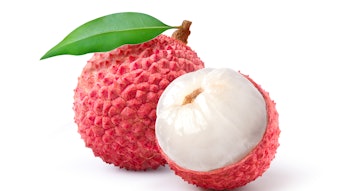
In today’s market, sugar reduction has taken center stage as consumers seek healthier options without sacrificing the familiar pleasures of sweetness, texture, and mouthfeel. Globally, 22% of consumersa are actively seeking foods that are low in salt, fat and sugar according to Innova Insights. However, replicating sugar’s sensory qualities in a way that satisfies consumer expectations presents significant technical challenges.
This article is only available to registered users.
Log In to View the Full Article
In today’s market, sugar reduction has taken center stage as consumers seek healthier options without sacrificing the familiar pleasures of sweetness, texture, and mouthfeel. Globally, 22% of consumersa are actively seeking foods that are low in salt, fat and sugar according to Innova Insights. However, replicating sugar’s sensory qualities in a way that satisfies consumer expectations presents significant technical challenges.
Perfumer & Flavorist+ (P&F+) enlisted the help of Sarah Diedrich the senior marketing director, Global Sweetening & Texturizing Solutions of ADM, and Ketan Shah, president of Esha Flavor Solutions, LLC, as well as Jingang "Jack" Shi, founder and CEO of EPC Natural Products Co. to share the obstacles the flavor industry faces when working with sugar alternatives, the role of biotechnology, and the impact of new ingredient technologies.
 Sarah Diedrich the senior marketing director, Global Sweetening & Texturizing Solutions of ADMcourtesy of ADM
Sarah Diedrich the senior marketing director, Global Sweetening & Texturizing Solutions of ADMcourtesy of ADM
P&F+: What are the main challenges you face when formulating with sugar alternatives in terms of taste, texture, and mouthfeel?
Sarah Diedrich [SD]: Successfully reducing sugars to replicate a full-sugar taste experience takes managing all the roles the sugars played in the end product. This certainly includes the sweetness, taste and mouthfeel of the food or beverage but also includes structural integrity, water retention, freeze-point, color, texture and much more. The biggest challenge becomes tailoring the perfect system of ingredients to build back the functionalities sugar provides all while adhering to brand parameters, calorie reduction and cost targets. It's finding that perfect solution for the application that not only hits all the technical and commercial needs but also delivers the best taste experience for the consumer.
It takes a holistic approach, informed by consumer insights and technical expertise to deliver the winning solution for each specific product.
Ketan Shah [KS]: There are raw materials available with biotechnology to meet the challenges of formulating with sugar alternatives, all a flavorist must do is build the flavor which would provide the enhancement of the sweetness to help the sugar alternatives, you also must use the materials to mask the aftertaste and add the mouthfeel nuances to deliver the replacement of sugar. It is easily achieved when you can use natural and artificial materials for this work but when you are tied to only using natural materials, you can deliver good results up to a point but not all the way to full sugar replacement.
 Ketan Shah, president of Esha Flavor Solutions, LLC
Ketan Shah, president of Esha Flavor Solutions, LLC
Jingang Shi [JS]: Formulating with sugar alternatives presents significant technical challenges, particularly due to the absence of the full-bodied mouthfeel provided by sucrose. Additionally, achieving a balanced sweet-sour profile is difficult, often resulting in an unharmonized sweetness perception characterized by a delayed onset, a diminished sweetness peak, and an undesirable lingering aftertaste. This misalignment in the sweetness-flavor profile can activate the brain's defect-detection mechanisms, ultimately reducing consumer satisfaction.
From my nearly two decades of experience working with Stevia, I consider the primary challenge to be the inherent complexity of steviol glycosides. These molecules exhibit diverse behaviors, which complicates the task of mastering their properties in food and beverage formulations. Furthermore, certain functional attributes of steviol glycosides, such as their foaming and gelling potential, remain areas of ongoing investigation, posing additional challenges for both formulators and producers.
The dissemination of knowledge surrounding these sweeteners is another significant barrier. Ingredient suppliers typically do not provide flavor-modifying products (FMPs), which are indispensable for optimizing the taste profiles of high-intensity sweeteners. The process of selecting the appropriate sweetener and compatible FMPs, and determining their precise concentrations at the parts-per-million level, demands both technical expertise and considerable patience. Thus, the development of sugar-reduced beverages is not merely a matter of creative formulation but one of scientific precision.
P&F+: Are there any emerging technologies or ingredients that have made it easier to work with sugar alternatives?
SD: Improved ingredient science and extraction and enzyme technologies have significantly advanced sweetening alternatives over the years. For example, stevia is a commonly used high-potency sweetener with clean label appeal. However, when stevia was introduced to the market almost 15 years ago, there was poor palatability with noticeable bitterness and off-notes and lack of understanding in formulation. Now, there is agronomy of new plant varietals with extraction efficiencies that deliver only the highest performing attributes of the stevia leaf.
Plus, with enzyme advancement, we have witnessed the creation of new proprietary solutions, such as reduced-sugar sweetening solutions that still have a caloric base, which is suitable for when a mid-calorie range is appropriate in foods. This is incredibly important for applications like gummies and baked goods, where the caloric sugar source plays multiple roles that impact taste beyond sweetness and flavor, ensuring enjoyable textures and functionality is still achieved.
These advancements allow for simple 1:1 replacements of ingredients for easy adoption and inclusion into existing formulations, driving formulators to revisit solutions in the toolbox.
Bringing flavor technology into the holistic sweetening system from the start is critical to developing an ideal reduced or zero-sugar food, beverage or dietary supplement. Advanced flavor technology paired with high-quality sweetening solutions enables ease-of-use in a formulation.
KS: Yes, the biotechnology and fermentation processes have made quite a bit of in-roads in this area but still there is work to be done.
With some proprietary materials I have reduced sugar to 70+% without using other sweeteners but you still must bring in mouthfeel and texture using flavor raw materials based on the end application.
 According to Jingang Shi, the dairy industry represents the second-largest category, for sugar alternatives, with a growing number of low-sugar or sugar-free products such as yogurt, ice cream, and flavored milk gaining popularity among health-conscious consumers.Adobe Stock
According to Jingang Shi, the dairy industry represents the second-largest category, for sugar alternatives, with a growing number of low-sugar or sugar-free products such as yogurt, ice cream, and flavored milk gaining popularity among health-conscious consumers.Adobe Stock
P&F+: What product segments are leading the demand for sugar alternatives?
SD: While, on average, 83% of global consumers are limiting or avoiding sugars in their diets, the importance put on different product segments variesb. Globally, non-alcoholic beverages continue to be a catalyst for sugar reduction and alternative sweetener use. For North American consumers, this is particularly top-of-mind, with 69% stating sweetening ingredients are most important when selecting a new carbonated soft drink, 66% for energy drinks and 63% for sports drinksb. For manufacturers, functional beverages provide a platform for unique sweetening technologies, helping not only reduce sugar content but also balance taste perception from off-notes that may come from functional ingredients or saltiness from a concentration of electrolytes.
Second to beverages, U.S. consumers are scrutinizing the sugar content in their sauces and snacks. Small serving sizes on a sauce can quickly increase sugar consumption across culinary dishes. Additionally, there is opportunity in functional snacking, which poses a compelling challenge to provide the right calorie needs for sustenance while limiting sugars and delivering great taste.
We have invested in sugar reduction consumer research across the globe, in 15 primary countries. This research allows us to analyze trends across segments from one region to the next, which can be especially important for international brands. The differences in attitudes and behaviors for sugars from Sao Paulo to Beijing is reported in our latest international insight research toolc. Each category presents its own unique considerations when selecting a reduced sugar product. For some products, like beverages, consumers are focused on added sugar counts; whereas for other more indulgent food categories, like confections and ice cream, consumers are more forgiving on sugars but selective on sweetener and ingredient choices.
JS: The beverage sector is currently the leading segment for sugar alternatives, largely driven by increasing public health concerns and evolving consumer taste preferences. Following closely, the dairy industry represents the second-largest category, with a growing number of low-sugar or sugar-free products such as yogurt, ice cream, and flavored milk gaining popularity among health-conscious consumers.
Confectionery products have also experienced heightened demand for sugar substitutes, as consumers increasingly seek indulgent options that are lower in sugar. Similarly, the bakery industry has witnessed significant reformulation efforts in products such as bread, muffins, and pastries to reduce sugar content while preserving sweetness and texture.
Lastly, the sauces category remains a crucial area of focus, with consumers favoring reduced-sugar or sugar-free alternatives of widely consumed condiments like ketchup and barbecue sauce. In this context, sugar alternatives are integral to maintaining flavor profiles while decreasing caloric content, thus driving innovation and reformulation efforts across the market.
 Jingang "Jack" Shi, founder and CEO of EPC Natural Products Co.
Jingang "Jack" Shi, founder and CEO of EPC Natural Products Co.
P&F+: How do you balance sweetness with maintaining flavor complexity and authenticity in reduced-sugar products?
JS: Balancing sweetness while maintaining flavor complexity and authenticity in reduced-sugar products presents a significant challenge, especially given the intricate interplay between sweetness perception and flavor. The question of responsibility for addressing this issue is crucial: Should ingredient suppliers or flavor houses take the lead? While flavor houses possess expertise in flavor creation and modulation, they often lack sufficient knowledge of high-intensity sweeteners, which are central to sugar reduction. Furthermore, achieving a compatible sweetness profile that aligns with authentic flavor perception requires a nuanced understanding of both sweeteners and flavor science. Current sweetener profiles can distort flavor perception, leading to an artificial taste experience, highlighting the need for a multifaceted approach to the problem.
Two strategies can be employed to address these challenges:
1. Selection of Appropriate Sweeteners
Synthetic sweeteners, such as aspartame, may offer a desirable sweetness profile but often raise health and regulatory concerns. Natural sweeteners like stevia and monk fruit, while perceived as healthier alternatives, can sometimes compromise flavor complexity due to aftertaste issues or less refined sweetness profiles. Bulking agents and sugar alcohols, although useful in replicating the mouthfeel and some sweetness characteristics of sugar, often fall short in terms of sweetness intensity due to dosage limitations. A more effective approach might involve utilizing advanced natural sweeteners with refined sweetness profiles combined with small amounts of bulking agents, which can help maintain health benefits while ensuring a balanced sweetness profile and flavor authenticity.
2. Employment of Flavor Modulators (or FMPs)
Flavor modulators are crucial in compensating for sweetness loss and enhancing the overall flavor experience in reduced-sugar products. Modulators that are designed to optimize sweetness while enhancing flavor perception through retronasal olfaction are particularly effective.
In conclusion, a collaborative approach between ingredient suppliers and flavor houses, combining expertise in both high-intensity sweeteners and advanced flavor technologies, is necessary to solve the challenge of balancing sweetness with flavor authenticity in reduced-sugar products. Consideration of sweetness, acidity, and flavor interactions should be integral to this process, requiring more than a one-dimensional focus on sweetness alone.
ahttps://www.innovamarketinsights.com/trends/sodium-reduction-trends/
bADM Outside Voice
chttps://www.adm.com/en-us/news/adm-stories/adm-launches-sweet-insights-tool-for-navigating-sugar-reduction-trends-worldwide/










